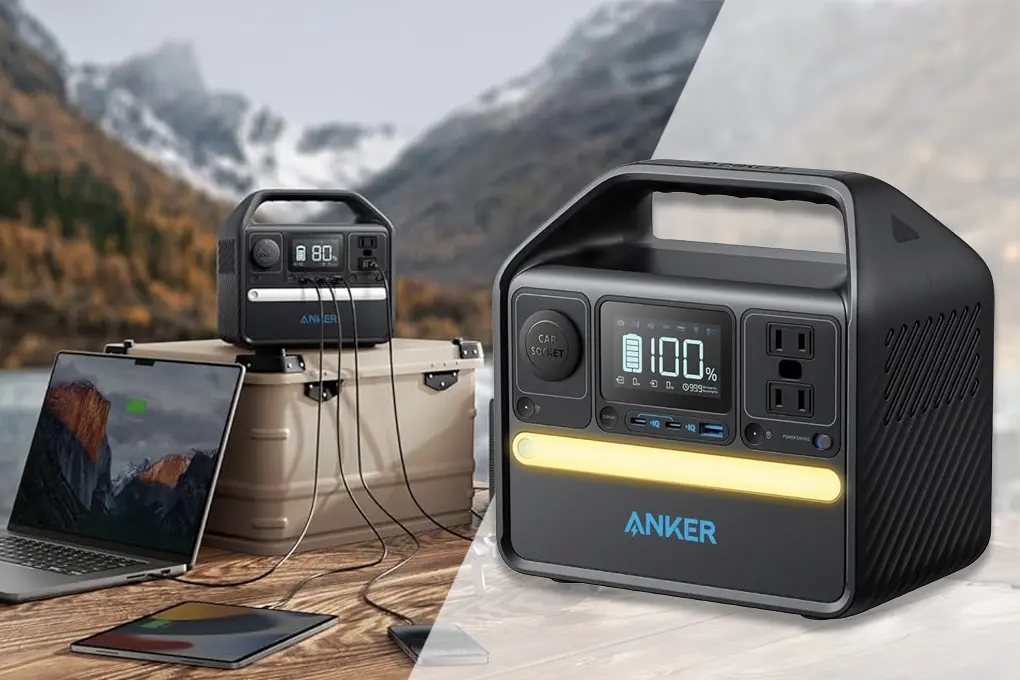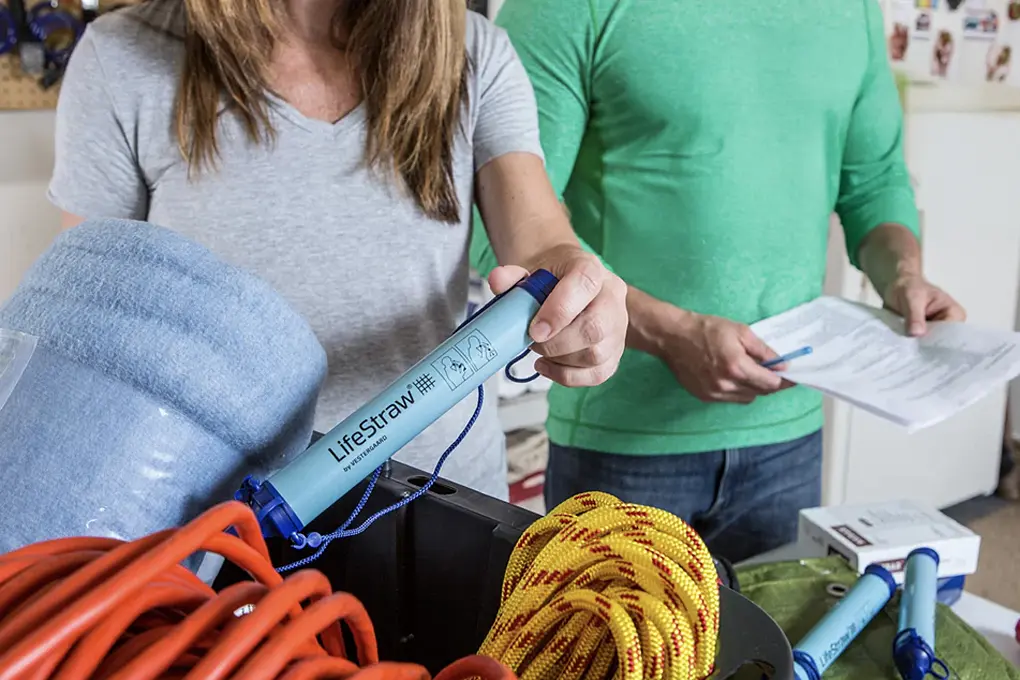Quick Answer: The best battery operated TV for hurricanes is a portable ATSC model with multiple power options, strong reception, and at least 3 hours of runtime. Top picks include the Tyler TTV705-14 for family viewing, the Wendry 12-Inch for evacuation kits, and the Milanix MX7 as a compact backup, all with car and AC charging.
When Hurricane Ida knocked out power to more than a million Louisiana homes in 2021, families were left in the dark for days.
Phones died within hours, Wi-Fi disappeared, and smart TVs turned useless. But those with battery operated TVs stayed connected to life-saving updates, tracking the storm and hearing evacuation alerts when they mattered most.
That’s the difference a portable TV can make. In the middle of a hurricane, it’s not a luxury – it’s a lifeline. If you’re getting ready for storm season, choosing the best battery operated TV for hurricanes ensures you and your family won’t be left guessing when the grid goes down.
Table of Contents
- Key Takeaways
- Why Battery Powered TVs Matter More Than Ever During Hurricane Season
- Top Battery Operated TVs for Hurricane Preparedness (2025 Testing Results)
- Critical Features for Hurricane-Ready Battery TVs
- Maximizing Battery Life During Extended Power Outages
- Alternative Power Solutions for Emergency Television
- Setting Up Your Hurricane TV System Before the Storm
- Building Redundancy: Why One Battery TV Isn’t Enough
- Maintenance and Storage Between Hurricane Seasons
- Real-World Lessons from Hurricane Survivors
- Making the Investment: Cost vs. Preparedness Value
- Conclusion: Your Information Lifeline When It Matters Most
- Frequently Asked Questions
- Sources
Key Takeaways
- 2024 brought 18 named storms and sustained outages; planning for visual updates adds safety when phones and internet fail.
- Top picks cover different needs: Tyler 14-inch for families, Wendry 12-inch for evacuation, Milanix 7-inch as a backup, Supersonic 12-inch for budget kits.
- Must-have features include ATSC tuner, multiple power sources, car charging, at least 3 hours of battery, and reception beyond 30 miles.
- Practical tactics extend runtime: brightness at 30 to 40 percent, short viewing windows, and shaded placement to reduce heat.
- Redundancy improves resilience: pair a primary TV with a compact backup and add solar, D-cells, or a small power station.
- Build a complete plan with Batten Emergency to select gear, organize your kit, and stay informed during outages.
Why Battery Powered TVs Matter More Than Ever During Hurricane Season
The frequency and intensity of hurricanes have continued to rise, with the 2024 Atlantic season producing 18 named storms and leaving widespread power outages across multiple states.
Preparing for these storms now goes beyond stocking water and non-perishables – it requires a reliable way to stay informed during extended blackouts. A battery operated TV fills this gap, providing steady access to local news, NOAA weather updates, and emergency briefings when cell towers fail and internet service cuts out.
A Step Ahead of Radios
Families caught in recent hurricanes have discovered that battery powered televisions offer advantages over other emergency devices. Weather radios, while useful, only provide audio. A portable TV lets you see storm tracking maps, evacuation routes, and live footage of damage and flooding.
During Hurricane Ian’s destructive impact on Florida in 2022, residents with portable TVs were able to watch real-time aerial coverage showing which neighborhoods were underwater, which roads remained open, and where shelters had space – information that directly influenced evacuation choices.
Real-Time Updates Save Lives
When power and internet connections are down, a visual feed of local coverage can be the difference between staying safe and being caught in harm’s way. Portable TVs provide a clearer picture of what’s happening outside your home, helping families make faster, more confident decisions during rapidly changing conditions.
Helping Families Stay Calm
The psychological benefit is just as important. Sitting in total darkness while winds roar outside can heighten fear, especially for children. Being able to watch familiar programming between weather updates can bring a sense of normalcy and calm. A battery operated TV not only keeps your household informed but also helps manage stress when the situation outside feels overwhelming.
Data Point: Current modeling indicates that annual outage hours may climb from single digits today to more than 800 hours by 2030, a shift that would disrupt millions of homes and businesses.
Top Battery Operated TVs for Hurricane Preparedness (2025 Testing Results)
After evaluating dozens of portable TVs through multiple storm seasons and gathering feedback from emergency management professionals across hurricane-prone regions, certain models consistently prove their worth when the power grid fails. These selections balance battery life, reception quality, durability, and ease of use during high-stress situations.
Quick Comparison: Top Battery TVs for Hurricane Season
|
Model |
Screen Size | Battery Life | Weight | Price Range |
Best For |
| Tyler TTV705-14 | 14″ | ~4 hours (rechargeable, car/AC options) | 4.8 lbs | $110-130 | Primary family viewing with strong connectivity |
| Wendry 12-Inch ATSC | 12″ | ~4 hours (car and AC charging) | 3.2 lbs | $150-160 | Compact evacuation use with versatile inputs |
| Milanix MX7 | 7″ | ~2.5 hours (lithium) or 6-8 hrs with AA backup | 1.5 lbs | Under $120 | Personal/backup unit; ultra-portable option |
| Supersonic SC-2812 | 12″ | ~3-4 hours (rechargeable; extends with car adapter) | 3.8 lbs | $100-120 | Budget-friendly family/emergency TV |
*When connected to car battery
Tyler TTV705-14: The Hurricane Workhorse
The Tyler TTV705-14 is one of the most reliable portable TVs for hurricane preparedness. Built with a 14.1-inch widescreen LCD display, it combines portability with clear 1080p resolution, making it an ideal companion when the grid goes dark.
During power outages, especially those caused by hurricanes, this unit ensures you can keep up with local news, weather alerts, and emergency broadcasts without relying on cable or internet access.
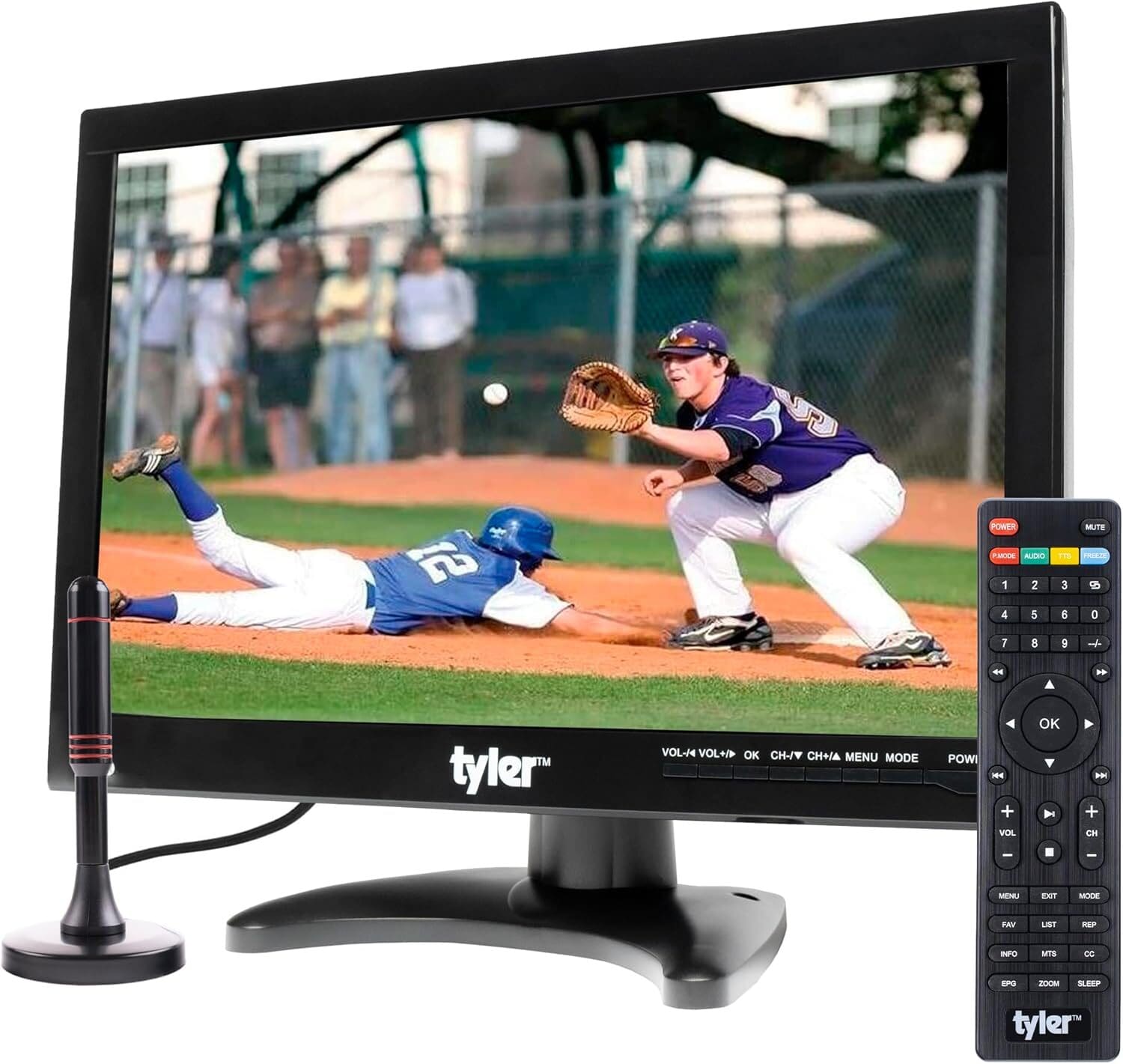
Specs
- Screen Size: 14.1 inches
- Weight: 4.77 pounds
- Resolution: 1080p (16:9 aspect ratio)
- Battery Life: 4+ hours per charge
- Power Options: Rechargeable lithium-ion battery, AC adapter, DC car charger
- Connectivity: HDMI, USB, RCA, AV inputs, headphone jack
- Speaker Type: Built-in dual speakers
- Dimensions: 6″D x 14″W x 14.1″H
- Price Range: $110-$130
Battery Life and Power Options
The built-in rechargeable lithium-ion battery provides up to four hours of viewing time on a single charge. For longer outages, the Tyler comes with both AC and DC charging options, including a car adapter.
This allows you to recharge from a vehicle if household power remains unavailable. Unlike many portable TVs that lock you into one charging method, the dual charging setup makes this unit far more practical during multi-day blackouts.
Connections and Compatibility
Connectivity is one of the Tyler’s biggest strengths. Equipped with HDMI, USB, RCA inputs, and dual AV ports, the unit connects seamlessly with external devices such as DVD players, gaming consoles, Roku, Apple TV, Firestick, or Chromecast.
It can also double as a computer monitor or security camera display, adding versatility well beyond storm use. This means you can keep children entertained with movies or games during stressful outages or use the screen as an emergency video feed if you have surveillance cameras installed.
Sound Quality and Viewing Experience
Two integrated built-in speakers provide solid sound with manual volume control, so there’s no need for external speakers. The 16:9 widescreen aspect ratio and crisp 1080p resolution make both news coverage and entertainment clear, even in low-light conditions when you’re running on minimal power.
Signal Reception and Emergency Coverage
The Tyler comes with two included antennas to maximize signal reception. During hurricane conditions, this becomes critical for maintaining access to local over-the-air channels when other services fail.
Its digital ATSC tuner supports both ATSC and NTSC broadcasts, so you’ll have reliable access to weather stations, live evacuation updates, and emergency management briefings.
The addition of an FM radio tuner provides yet another way to stay connected if television signals weaken.
Why It’s Ideal for Hurricanes
What makes the Tyler TTV705-14 stand out during emergencies is its blend of long battery life, multiple charging options, wide connectivity, and dependable signal reception.
At just under 5 pounds, it’s light enough to move from room to room or pack into an evacuation vehicle. For under $110-$130, it delivers a balance of durability and functionality that makes it a practical investment for anyone living in hurricane-prone areas.
Data Point: The DOE warned that without new generation resources, power outages could multiply by 100 times within the next five years, especially during peak demand periods.
Wendry 12-Inch ATSC Portable TV: Compact Emergency Essential
The Wendry 12-Inch ATSC Portable TV is designed for those who value portability and flexibility during emergencies. With a 12-inch LCD screen, rechargeable battery, and lightweight design, it slips easily into an evacuation kit or vehicle. While compact, it still provides reliable access to digital broadcasts, making it an excellent choice for hurricane preparedness and prolonged outages.
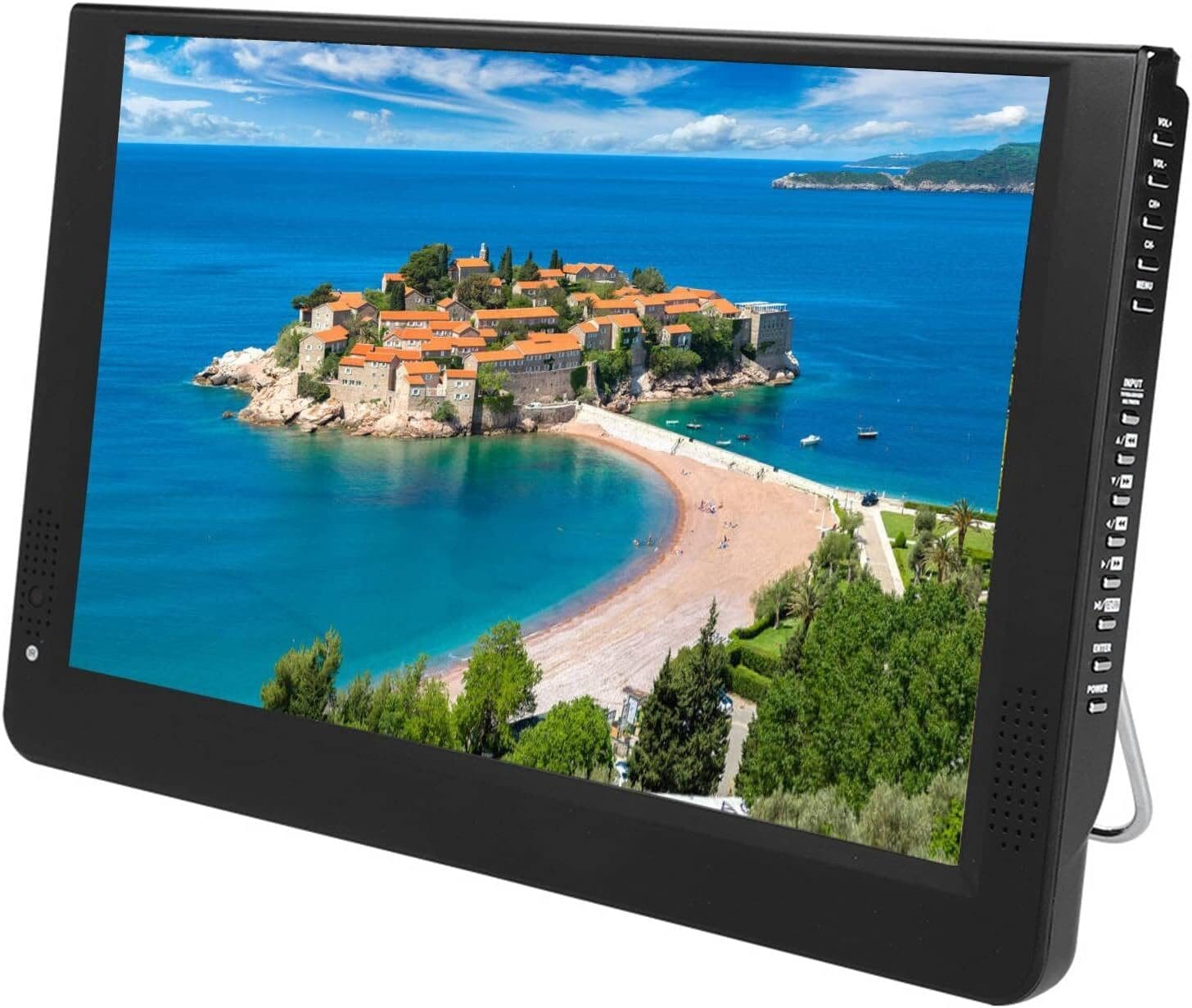
Specs
- Screen Size: 12 inches
- Weight: 3.2 pounds (1.45 kg)
- Resolution: 1280 x 800 (supports 1080p input)
- Battery Life: Approx. 4 hours per charge
- Power Options: Rechargeable lithium battery, AC adapter, 12V car adapter
- Connectivity: HDMI, USB, VGA, AV in/out, SD card slot, headphone jack
- Speaker Type: Stereo (2.0 channel, 5W output)
- Dimensions: 30.7 x 19.8 x 2.5 cm
- Price Range: $150-$160
The Wendry 12-Inch ATSC Portable TV is designed for those who value portability and flexibility during emergencies. With a 12-inch LCD screen, rechargeable battery, and lightweight design, it slips easily into an evacuation kit or vehicle. While compact, it still provides reliable access to digital broadcasts, making it an excellent choice for hurricane preparedness and prolonged outages.
Battery Life and Power Options
The built-in rechargeable battery provides around four hours of playback under normal settings. Included AC and 12V car adapters allow you to recharge even when household power is down, making it dependable for multi-day outages. One caveat: using the USB port to charge other devices can shorten runtime by about 20%, so it’s best reserved for critical recharges only.
Connections and Compatibility
This model offers broad compatibility with HDMI, USB, VGA, AV inputs, and SD cards, giving you plenty of options to connect external media. Whether you’re watching preloaded movies, connecting a gaming console to a generator, or using it as a computer monitor, the Wendry adapts easily. This versatility helps keep both information and entertainment accessible during stressful conditions.
Sound Quality and Viewing Experience
The stereo speakers deliver a maximum output of 5 watts, which is more than adequate for small rooms or indoor storm shelter use. The 1280 x 800 resolution ensures that both video and text remain clear from several feet away, making it easy to follow scrolling weather alerts and maps. Its 16:9 widescreen display provides a natural format for both news broadcasts and streaming content from connected devices.
Signal Reception and Emergency Coverage
With its ATSC tuner, the Wendry maintains stable reception of over-the-air digital channels. Field use shows the antenna works best when extended near a window and angled for signal optimization. The unit is capable of pulling in local weather updates, live evacuation alerts, and emergency briefings, which are vital during hurricane conditions when internet and cable services are unavailable.
Why It’s Ideal for Hurricanes
The Wendry 12-Inch Portable TV combines portability, flexible charging, and solid reception in a compact form. At just over 3 pounds, it’s light enough to add to a go-bag without taking up valuable space.
Its ability to run on rechargeable power, recharge from a vehicle, and support multiple media inputs makes it practical for both emergency preparedness and everyday portable use. While it costs a bit more than some competitors, its versatility and compact build make it a dependable backup during hurricanes along with your other hurricane essentials.
Data Point: According to a recent Department of Energy report, the United States could see blackouts increase up to 100-fold by 2030 if firm power capacity is not added as demand rises and traditional plants are retired.
Milanix MX7 7-Inch: The Backup’s Backup
The Milanix MX7 proves that sometimes smaller is smarter. This ultra-portable 7-inch LCD TV has become a popular backup choice in hurricane prep kits thanks to its compact size, flexible power options, and surprising versatility. It’s not designed to replace a full-sized portable TV, but it excels as a personal device for family members or as a secondary unit when redundancy is critical.

Specs
- Screen Size: 7 inches
- Weight: 1.5 pounds
- Resolution: 720p (LCD display)
- Battery Life: Approx. 2.5 hours on rechargeable battery; optional 6 AA batteries for backup
- Power Options: Built-in lithium battery (USB, AC/DC wall jack, 12V car cord), AA batteries
- Connectivity: USB, SD card slot, AV input, coaxial antenna, headphone jack
- Speaker Type: Built-in stereo speakers
- Dimensions: Compact, ultra-portable design with 2-way hands-free stand
- Price Range: Under $100-$120
Battery Life and Power Options
The Milanix MX7’s rechargeable lithium battery delivers about 2.5 hours of continuous playback on a single charge. Where it stands out is its flexibility: in addition to AC and 12V car charging, it can also run on six AA batteries, which are widely available and easy to pack for emergencies. Users also report excellent efficiency when paired with portable power banks, allowing extended run times during long outages.
Connections and Compatibility
Despite its small size, the MX7 is loaded with connectivity options. It includes USB and SD card slots, AV input, coaxial antenna support, and a headphone jack, along with built-in stereo speakers. This makes it easy to play preloaded movies, connect external devices, or watch over-the-air broadcasts. The included remote control adds convenience, especially when using it in tight spaces like shelters or vehicles.
Sound Quality and Viewing Experience
The 7-inch LCD screen delivers 720p resolution, which is more than sufficient for a compact personal TV. Colors and clarity hold up well at short distances, making it ideal for individual viewing. The built-in speakers provide adequate sound, though most users prefer to plug in headphones for clearer audio during noisy storm conditions.
Signal Reception and Emergency Coverage
Reception is handled by an external high-power boosted antenna, which improves performance compared to many other small-screen models. While placement near a window still helps, the Milanix consistently pulls in local ATSC digital channels for weather alerts, live news, and evacuation updates. This capability makes it a dependable emergency companion despite its modest size.
Why It’s Ideal for Hurricanes
The Milanix MX7 isn’t meant to be your primary household emergency TV, but it excels as a backup device or personal screen for family members. At just 1.5 pounds, even children can carry it easily, and the rubberized exterior provides some protection against bumps and drops. Its ability to run on AA batteries or sip power from a portable bank adds resilience during extended outages. At under $120, it’s an affordable way to build redundancy into your hurricane preparedness plan.
Supersonic SC-2812 12-Inch: Budget-Friendly Reliability
The Supersonic SC-2812 is a reliable option for those who want an affordable portable TV without sacrificing key emergency features. With a 12-inch widescreen LED display, built-in rechargeable battery, and flexible AC/DC operation, this unit delivers consistent performance during power outages and on the road. It’s designed for both home and mobile use, making it a smart addition to hurricane prep kits.
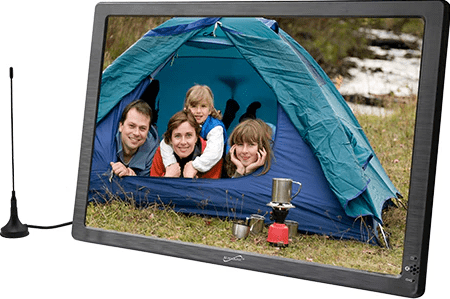
Specs
- Screen Size: 12 inches
- Weight: Lightweight, portable design
- Resolution: 1280 x 800 (16:9 aspect ratio)
- Battery Life: Built-in rechargeable lithium battery (runtime varies ~3-4 hours)
- Power Options: AC adapter, DC 12V car adapter, rechargeable lithium battery
- Connectivity: HDMI, USB, AV input/output, earphone jack
- Speaker Type: Built-in stereo speakers (2 x 1W)
- Dimensions: Compact 12-inch widescreen with rotary rod antenna
- Price Range: $100-$120
Battery Life and Power Options
The SC-2812 is equipped with a built-in lithium-ion battery, offering several hours of operation on a single charge. For extended use, it can run directly on 12V DC power via the included car adapter, or through standard AC household power when available. This versatility means you can recharge while driving, run it directly off a car battery, or keep it powered indoors with minimal interruption.
Connections and Compatibility
This model is designed for flexibility, with HDMI, USB, and AV input/output ports, plus an earphone jack. The USB port allows playback of video and audio files from external devices, while HDMI compatibility makes it easy to connect streaming sticks, DVD players, or gaming consoles. These options provide both entertainment and practical uses during long outages.
Sound Quality and Viewing Experience
The 1280 x 800 resolution ensures a clear picture, and the 16:9 aspect ratio provides a true widescreen viewing experience. With a brightness rating of 500 cd/m² and wide 165° viewing angle, the display remains sharp in most indoor and outdoor conditions. Built-in stereo speakers (2 x 1W) provide adequate audio for small spaces, and the earphone jack allows private listening in shelters or noisy environments.
Signal Reception and Emergency Coverage
Equipped with a built-in ATSC/NTSC tuner and a rotary rod antenna, the SC-2812 reliably receives local digital broadcasts. This means you can track hurricane paths, monitor evacuation updates, and stay connected to emergency alerts when other systems are down. The addition of a built-in FM radio offers another way to receive updates when television signals are weak.
Why It’s Ideal for Hurricanes
The Supersonic SC-2812 balances affordability, versatility, and reliability. Its combination of a built-in battery, multiple charging options, and strong tuner reception makes it dependable during extended outages. Lightweight and compact, it’s easy to keep stored until needed and quick to set up when storms hit. At around $100-$120, it’s a budget-friendly option that doesn’t compromise on the essentials for hurricane preparedness and travel disaster planning alike.
Critical Features for Hurricane-Ready Battery TVs
Choosing the right battery operated TV for hurricane preparedness means focusing on features that truly matter during emergencies. Based on feedback from emergency management coordinators and families who have endured multiple storms, several capabilities consistently stand out as essential, while others are useful but not critical.
Essential Features Checklist
Must-Have Features
- Multiple power options (rechargeable battery plus replaceable batteries)
- ATSC digital tuner (preferably ATSC 3.0 compatible)
- 12V car adapter included
- Minimum 3-hour battery runtime
- Weather-resistant casing or protective coating
- Manual antenna adjustment capability
- Reliable reception from 30+ miles away
Nice-to-Have Features
- USB charging port for small devices
- HDMI and AV inputs for external players or streaming devices
- Built-in AM/FM radio for backup communication
- Carrying handle or protective case
- Remote control with backup manual buttons
- Sleep timer to conserve battery life
Power System Flexibility
Power options remain the single most important feature for hurricane-ready TVs. A dependable unit should include a rechargeable lithium battery, support for replaceable batteries (AA or D-cell), a 12V car adapter, and a standard AC adapter.
This flexibility ensures that you can keep the TV running whether you are at home, in a shelter, or on the move. Devices that only rely on proprietary rechargeable batteries are limited once the charge is gone, while those that accept standard batteries can run indefinitely as long as you maintain a supply.
Tuner Performance and Reception
The quality of the ATSC digital tuner will determine if you can receive critical broadcasts during a storm. Some tuners lose signals quickly under poor conditions, while stronger models continue to pull in channels even as the weather deteriorates.
Where possible, choose a TV that specifies ATSC 3.0 compatibility, which provides improved reception, more robust emergency alert integration, and clearer broadcasts. Having a tuner capable of maintaining reception from 30 miles or more is a practical benchmark for storm preparation.
Screen Size
| Screen Size | Best Use Case | Power Consumption | Viewing Distance | Group Size |
| 7-9″ | Personal/backup use | 5-8W | 2-3 feet | 1-2 people |
| 10-12″ | Small family viewing | 10-15W | 4-6 feet | 2-4 people |
| 14-16″ | Primary family TV | 15-25W | 6-10 feet | 4-6 people |
| 19″+ | Community viewing | 25W+ | 10+ feet | 6+ people |
Durability and Weather Resistance
Durability and weather resistance become especially important during hurricane conditions. While no electronic device should be exposed directly to heavy rain or flooding, high humidity and temperature swings are unavoidable. Portable TVs with rubberized exteriors and sealed input ports hold up better in damp environments and are less prone to corrosion or shorting.
Some manufacturers also provide protective cases, moisture-resistant screens, or reinforced housings that add another layer of defense. These features are particularly valuable for residents in coastal areas where salty air accelerates wear on electronics. For added longevity, storing the TV in a dry box or waterproof bag when not in use can help prevent damage between storm seasons.
Maximizing Battery Life During Extended Power Outages
The difference between a portable TV lasting two days versus five days often comes down to power management. Families and preppers who endured week-long outages after major hurricanes have shared strategies that make limited battery reserves last significantly longer without sacrificing access to essential updates.
Power Conservation Schedule
One of the most effective approaches is creating a viewing schedule rather than keeping the TV on continuously. After Hurricane Michael, families reported that 15-minute updates every two to three hours provided enough information while keeping power consumption manageable. This practice not only conserved energy but also reduced the risk of screen burn-in from static emergency broadcast graphics.
Sample Viewing Schedule During Outages
- 6:00 AM: Morning weather and news update (15 minutes)
- 10:00 AM: Mid-morning emergency briefing check (10 minutes)
- 2:00 PM: Afternoon update (15 minutes)
- 6:00 PM: Evening news coverage (30 minutes)
- 10:00 PM: Final night update (15 minutes)
Total daily use: about 85 minutes, which can stretch a 4-hour battery to nearly three days.
Battery Life Extension Techniques
In addition to careful scheduling, making small adjustments to your TV’s settings can extend runtime significantly.
Power Saving Settings by Priority
- Reduce screen brightness to 30-40% (extends runtime by up to 50%)
- Lower speaker volume and rely on closed captions (saves 10-15%)
- Turn off auto-scan and background search features (saves 5-10%)
- Keep the unit in a cool, shaded location to reduce heat-related drain (saves 10-20%)
- Use eco or economy mode if the TV includes it (saves 15-25%)
A practical tip from storm survivors is to set the TV in a darkened corner or under a simple viewing hood. This makes it comfortable to watch at much lower brightness settings, even during the day.
Supplementing With External Power
Backup power banks and solar charging setups can make a critical difference during extended blackouts. A 30,000mAh portable power bank can add two to three full charges to most 12-inch TVs, tripling their runtime.
Compact solar panels, when paired with these power banks, can provide renewable energy between storm bands. During Hurricane Maria in Puerto Rico, this combination allowed households to maintain access to broadcasts for weeks while waiting for grid power to be restored.
Alternative Power Solutions for Emergency Television
Beyond traditional battery operation, creative power solutions can maintain television access throughout extended hurricane recoveries. These approaches, refined through real-world disasters, provide the redundancy serious preppers demand while remaining accessible to preparation newcomers.
Power Solution Comparison
| Power Source | Runtime | Cost | Setup Complexity | Best For |
| Portable Power Station | 15-20 hours | $300-600 | Easy | Extended outages |
| Car Battery System | Unlimited* | $30-50 | Moderate | Vehicle evacuations |
| D-Cell Adapters | 40-50 hours | $80-100 | Easy | Long-term backup |
| Solar Direct | Daylight hours | $150-300 | Moderate | Sunny post-storm |
| Generator | Unlimited* | $400-2000 | Complex | Home sheltering |
*With fuel/vehicle access
When outages stretch for days, relying only on a built-in TV battery is rarely enough. Many families supplement with external power sources that extend runtime and provide energy for other essential devices. Two of the most effective options are portable power stations and car battery systems.
Portable Power Stations
Portable power stations such as the Jackery Explorer 500 or the EcoFlow River have become popular with hurricane preppers. These units can power a 12-inch portable TV for 15 to 20 hours per charge, while also running LED lights and charging multiple phones.
During the 2024 hurricane season, households reported maintaining regular TV viewing schedules for three to four days on a single charge.
Their real strength lies in recharging flexibility. Most models accept input from solar panels, car outlets, or small generators, making them sustainable during extended outages. While these stations require an upfront investment, their reliability and ability to power multiple devices make them valuable additions to an emergency kit.
Car Battery Systems
For an even simpler solution, many families turn to their vehicles. With a basic 12V inverter (often available for under $30), a car battery can power most portable TVs indefinitely when managed carefully. To avoid draining the vehicle battery, running the engine for about 15 minutes every few hours is usually enough to restore charge.
Some evacuees also position vehicles strategically to improve reception, threading antenna cables through a slightly cracked window to maintain a seal against rain while boosting signal strength. This method not only powers the TV but also provides charging capacity for phones and radios, making it a practical fallback when portable stations are not available.
D-Cell Batteries & Runtime Chart
D-cell batteries remain a reliable fallback for many portable TVs. Their availability in most stores makes them a dependable choice for emergency kits, though costs can add up during prolonged outages.
| TV Size | Battery Count | Expected Runtime | Cost Per Hour |
| 7″ | 6 D-cells | 8-10 hours | $0.75 |
| 10″ | 8 D-cells | 6-8 hours | $1.25 |
| 12″ | 10 D-cells | 5-6 hours | $1.75 |
| 14″ | 12 D-cells | 4-5 hours | $2.40 |
Larger screens naturally consume more energy, making smaller models far more cost-efficient when relying solely on D-cells. Rotating usage schedules, as discussed earlier, helps stretch these runtimes significantly.
Solar Panel Direct Connection
For TVs with a 12V input, portable solar panels provide a renewable solution. A 100W solar panel can run most 12-14 inch TVs during daylight hours while also charging external battery banks for nighttime viewing.
This method was especially valuable after Hurricane Katrina, when fuel shortages limited generator use but clear skies allowed solar charging to fill the gap.
Modern folding solar panels are lightweight, easy to store, and often include built-in regulators to prevent overcharging. Pairing them with large-capacity power banks or portable stations ensures continuous access to broadcasts during long recovery periods.
Setting Up Your Hurricane TV System Before the Storm
Preparing your portable TV before hurricane season ensures you won’t waste valuable time troubleshooting equipment when storms are approaching. Families in hurricane-prone regions have developed systematic approaches that make sure their emergency TV is ready for immediate use.
Pre-Season Setup Checklist
Establishing the right setup in advance is the foundation of reliable performance. Start with antenna testing during clear weather and note the exact angle and extension that deliver the strongest reception for local news, weather, and emergency broadcasts.
Essential Setup Tasks
- Test all power adapters, chargers, and cables
- Mark optimal antenna positions with tape or marker
- Program all available channels into memory
- Create a laminated channel guide with frequencies
- Perform a full discharge test to check battery runtime
- Store fresh backup batteries in a sealed container
- Update TV firmware if applicable
- Clean antenna contacts and TV input ports
- Verify reception from your designated viewing area
- Ensure all family members can operate the TV independently
Some preppers also install permanent external antennas in attics or sheltered areas, running coaxial cables into safe viewing spaces. This preparation eliminates the need to adjust antennas during high winds or heavy rain.
Channel Programming Guide Template
Organizing a quick-reference channel list makes it easier to locate vital broadcasts during emergencies. Here’s a sample format that can be customized for your region:
| Channel | Network | Type | Frequency | Notes |
| 2.1 | CBS | News | VHF | Strongest signal |
| 7.1 | ABC | News | VHF | Weather radar |
| 11.1 | NBC | News | VHF | 24/7 coverage |
| 13.1 | PBS | Emergency | VHF | NOAA backup |
| 24.1 | Weather | Dedicated | UHF | Continuous radar |
| 36.1 | Fox | News | UHF | Traffic cameras |
This guide can be laminated and stored with the TV for fast access.
Building a Dedicated Emergency Kit
Keep your hurricane TV and accessories together in a single kit so they’re ready year-round.
The kit should include:
- Charging cables and adapters
- Fresh batteries and spares
- Antenna extensions
- Quick-reference instructions (laminated if possible)
Many families also prepare laminated button guides that highlight essential controls. This ensures anyone, even someone unfamiliar with the device, can operate it during an emergency. This kit should integrate seamlessly with your broader crisis food security measures and other emergency supplies.
Ongoing Maintenance and Testing
Testing your system on a monthly basis during hurricane season ensures that it works when needed. Check battery charge levels, confirm reception quality, and practice operation with each family member. Regular maintenance also helps catch problems like degraded batteries, corroded contacts, or firmware updates before they become failures during a storm.
Building Redundancy: Why One Battery TV Isn’t Enough

Experienced hurricane survivors know that relying on a single device often leads to failure when it matters most. A solid emergency communication plan should include multiple layers of backup so that information access continues even if one unit malfunctions or becomes damaged.
The Two-Is-One Philosophy
A common strategy is to pair a primary 14-inch portable TV for family viewing with a compact 7-inch backup. This setup allows for shared viewing at home while also ensuring portability during evacuation.
If family members must split between shelters, each group retains access to critical broadcasts. Storing the two units in different locations – such as one in your main emergency kit and another in a vehicle or secondary shelter – further reduces the risk of total equipment loss.
Diversifying Reception Methods
Redundancy should extend beyond television alone. Many newer portable TVs include built-in FM radio tuners, which continue to function when TV signals weaken.
In some cases, smartphone streaming remains available if cellular networks hold up, though conserving data is important during extended outages.
Preppers also recommend USB TV tuners for laptops, which transform existing devices into additional receivers, adding another layer of resilience.
Complementary Communication Tools
Battery TVs are most effective when integrated into a wider communication network. They provide visual clarity that radios cannot, but they should not replace NOAA weather radios, ham radios, or emergency broadcast apps.
Cross-training family members on how to use each tool ensures that information keeps flowing regardless of which system is available. This layered approach reduces reliance on any single device and becomes especially important when considering how to communicate in emergencies without cell service.
Community Resource Sharing
Individual preparedness has limits, especially during prolonged outages. Some neighborhoods coordinate equipment resources so that if one household loses its TV but another still has a functioning radio, both groups remain informed.
This type of information sharing was particularly useful during Hurricane Sandy, when fuel shortages and equipment failures left many families relying on their neighbors’ systems to stay updated.
Maintenance and Storage Between Hurricane Seasons
Proper off-season maintenance ensures your battery TV performs when needed most. Devices that sit idle for months are more likely to fail at critical moments, but simple storage protocols can prevent these issues and extend equipment life.
Battery Maintenance Schedule
Rechargeable batteries require particular care during long-term storage. They should be kept at around 60% charge, since both full depletion and full charge accelerate chemical degradation. A quarterly schedule helps maintain capacity and prevents failures:
Quarterly Maintenance Tasks
- Month 1: Discharge and recharge the built-in battery to about 60%
- Month 2: Test all functions and clean contacts
- Month 3: Perform a full discharge and recharge cycle
- Month 4: Inspect for corrosion and replace desiccant packs
Removable batteries should be stored separately in a cool, dry location. Heat and humidity, common in hurricane-prone regions, shorten battery lifespan significantly. Many preppers use sealed ammunition boxes with silica gel or other desiccants for storage, rotating stock to keep batteries fresh.
Storage Best Practices
Environmental control during storage adds years to the life of your equipment. Even small investments in proper containers and moisture protection can make a difference when storms arrive.
Storage Requirements By Component
| Component | Storage Temp | Humidity | Container Type | Check Frequency |
| TV Unit | 60-75°F | <50% | Plastic bag with desiccant | Quarterly |
| Lithium Batteries | 55-70°F | <40% | Sealed container | Monthly |
| Alkaline Batteries | 50-70°F | <35% | Original packaging | Bi-monthly |
| Cables/Adapters | Any indoor | <60% | Labeled zip bag | Annually |
| Antenna | Any indoor | Any | Stored extended | Quarterly |
Annual Testing Protocols
Before hurricane season begins (typically May in the Atlantic), conduct a full system test under simulated emergency conditions. This includes:
- Running the TV on battery power for its full rated duration
- Testing all inputs, adapters, and power options
- Verifying channel reception quality
- Documenting any degraded performance for replacement planning
These checks reveal weak batteries, failing connections, or outdated firmware before storms threaten. Addressing issues in advance ensures that your system will operate without delays when emergencies occur.
Real-World Lessons from Hurricane Survivors
The real test of emergency equipment comes during disasters. Families who have lived through multiple hurricanes share insights about battery TV use that go beyond manufacturer specifications and highlight practical lessons learned under pressure.
Reception Challenges During Flooding
During Hurricane Harvey’s flooding in Houston, many families discovered that reception degraded more than expected when water levels rose. Water-saturated air weakens signal propagation, forcing frequent antenna repositioning as conditions changed.
Those who set up TVs on higher floors reported more consistent reception. The same principle applies during storm surge events, making it wise to plan ahead for potential water infiltration when positioning equipment.
Coordinated Power Management
Extended outages after Hurricane Irma revealed the importance of staggering energy use. Families who ran TVs, phone chargers, and cooking appliances simultaneously saw batteries drain quickly. In contrast, households that scheduled activities in rotation preserved reserves for days. Coordinating viewing times with charging and meal preparation requires family discussion before a storm hits, helping avoid conflict when stress levels rise.
Verifying Information Sources
After Hurricane Michael, survivors stressed how vital it was to confirm information from multiple sources. Battery TVs allowed families to cross-check social media claims against official broadcasts. This prevented dangerous mistakes, such as evacuating toward flooded roads or returning to unsafe areas. The ability to visually confirm evacuation routes and storm damage proved invaluable for decision-making.
Community-Based Solutions
In Puerto Rico, where Hurricane Maria left some regions without power for months, battery TVs became more than just a news source. Families created community viewing schedules, pooling power resources and gathering for evening broadcasts.
These shared experiences boosted morale and provided a sense of normalcy during prolonged recovery. This community-driven approach highlights the social value of preparedness alongside individual readiness.
Making the Investment: Cost vs. Preparedness Value
Battery operated TVs may not see daily use, but their long-term value becomes clear when comparing cost to the risks of being uninformed during a disaster.
Cost-Benefit Perspective
A quality unit typically costs $100 to $300, which averages to less than $30 annually when spread over a 5-10 year lifespan. This is comparable to two months of cable service or a single family dinner out. Against that, the costs of unnecessary evacuations, hotel stays, or worse – failing to evacuate in time – are significantly higher.
Insurance And Recovery Considerations
While homeowners’ insurance policies do not offer direct discounts for preparedness equipment, adjusters consistently report that prepared households file fewer claims and recover more quickly. Having reliable access to timely updates directly reduces property damage and displacement costs.
Everyday and Psychological Benefits
The usefulness of battery TVs extends beyond hurricane season. They prove valuable during thunderstorms, routine outages, camping trips, tailgates, and even garage workshops. This flexibility turns them into household tools rather than single-purpose devices.
Equally important is the psychological reassurance they provide. Parents have used them to keep children calm with familiar programming during frightening storms. Elderly residents isolated during outages found comfort in maintaining a visual connection to the outside world. These benefits cannot be measured purely in dollars but are often what families remember most when reflecting on how they endured a disaster.
Battery TVs prove valuable during regular power outages, severe thunderstorms, and other emergencies that Batten Emergency helps you prepare for.
Conclusion: Your Information Lifeline When It Matters Most
A battery operated TV can be the difference between guessing and knowing during a hurricane. The models reviewed here pair reliable ATSC reception with flexible power options so you can track local news, NOAA updates, and evacuation guidance when the grid fails.
The Tyler TTV705-14 suits family rooms, the Wendry 12-Inch fits go-bags, and the Milanix MX7 adds redundancy without bulk. Key features matter most under stress, so prioritize multi-source power, a capable tuner, and at least a 3-hour battery.
Extend runtime with simple habits such as lower brightness and scheduled check-ins. Round out your kit with an external antenna, vehicle charging, and a small power station for multi-day outages. For a complete, confidence-building plan, pair the right TV with a layered emergency setup.
Ready to strengthen your family’s hurricane preparedness beyond just emergency television? Build a complete disaster readiness plan with expert-vetted gear and guidance at Batten Emergency – where security meets simplicity.
Frequently Asked Questions
What Screen Size Works for Families During Outages?
Aim for 12 to 14 inches for shared viewing in a small room. That range balances readable maps and crawl text with reasonable power draw. A 14-inch unit like the Tyler TTV705-14 covers group updates, while a 7-inch model works as a personal backup for a child or caregiver. Keep brightness around 30 to 40 percent and use captions to conserve battery.
Do I Need ATSC 3.0 for Hurricane Coverage?
ATSC 1.0 remains the baseline for local emergency broadcasts and is widely available. ATSC 3.0, also called NextGen TV, can improve reception and alert features where stations support it. If your market has 3.0, choosing a compatible set adds resilience. If it does not, a strong ATSC 1.0 tuner with a good antenna still performs well during storms.
Which Antenna Type Improves Reception in Severe Weather?
Start with the included antenna for quick setup, then keep a compact amplified indoor antenna as a backup. Elevate it near a window and note the best orientation for local stations before storm season. A short coax extension lets you place the antenna for signal strength while keeping the TV in a protected location. Carry spare adapters in your kit.
How Can I Power a Portable TV from a Vehicle Safely?
Use the 12V car adapter or a small inverter rated above the TV’s draw. To protect the vehicle battery, run the engine for brief intervals while charging. Route cables through a slightly open window to avoid pinching and keep the exhaust area clear. Consolidate charging sessions by topping up phones and radios during the same runtime.
What Should I Pack with the TV in a Hurricane Kit?
Bundle the TV with its AC charger, 12V adapter, a compact amplified antenna, coax extension, and spare batteries if supported. Add a laminated local channel guide, quick settings card for brightness and volume, and a dry bag for humid conditions. Include a small power bank or portable power station to extend runtime during multi-day outages.
How Do I Keep Updates Flowing if Signals Drop?
Layer your sources. Keep the TV ready for visual coverage, an FM radio for audio when TV reception weakens, and a charged phone for weather apps if cellular service returns. A USB TV tuner for a laptop adds another receiver. Use a viewing schedule with short check-ins, lower brightness, and shaded placement to conserve power while staying informed.
Sources
- Rescuers rush to save those stranded by Hurricane Ida amid ‘catastrophic’ power outage | CBC News
- 2024 Atlantic Hurricane Season – Center for Disaster Philanthropy
- Hurricane Ian’s Path of Destruction | NESDIS | National Environmental Satellite, Data, and Information Service
- US DoE report warns of 100-fold increase in power outages by 2030
- Lack of new US power capacity could increase blackouts 100 times by 2030, says Energy Department | Reuters
- DOE Final EO Report (FINAL JULY 7)_0.pdf


